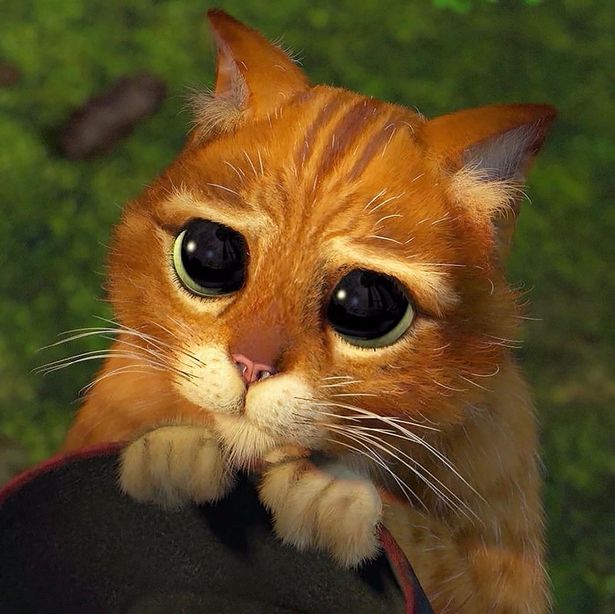DreamWorks Pictures reintroduces us to some familiar faces from fairy tales – with a comedic twist! The world of Far Far Away parodies and subverts traditional ideas of what a ‘happily ever after’ means. In this universe, the monsters of the story are now the good guys, and our frightening but lovable ogre protagonist must fight against the prejudices created against him with the help of his furry sidekicks. Even these animal characters from our childhoods are reimagined, and how they are presented gives us a new spin on a familiar tale.
When Shrek and Donkey are sent to the forest following King Harold’s instructions, they encounter the greatest assassin in all of Far Far Away – Puss-in-Boots, a Zorro-like musketeer. For those unaware, Puss-in-Boots’ appearance and attitude is a reference to his voice actor Antonio Banderas’s role in the 1998 film, The Mask of Zorro. However, the film goes beyond a simple parody and reference to Banderas’s work in how Puss is presented. The film blends 19th Century French literary culture with a naturalistic portrayal of animal behaviour. The original Puss-in-Boots is a character from iconic French author Charles Perrault, and he is presented as an anthropomorphic cat who uses trickery to gain wealth and status for his poor master. Initially through this scene, we see these noble traits from Puss – before starting the fight, he threatens Shrek whilst standing upright and pointing his rapier. However, Shrek isn’t so scared of him, exclaiming, “Oh look, a little cat.” His preconceptions of what a cat is make Shrek let his guard down which allows Puss to pounce. Before he attacks Shrek, he gets into an ‘alert position’; observing emotions in cats is often done by their body language, and when a cat is alert and ready to strike their prey, they crouch down and wag their tails (observe figure 1 and 2).
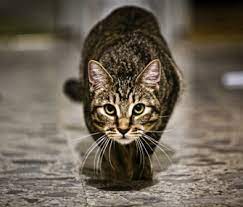
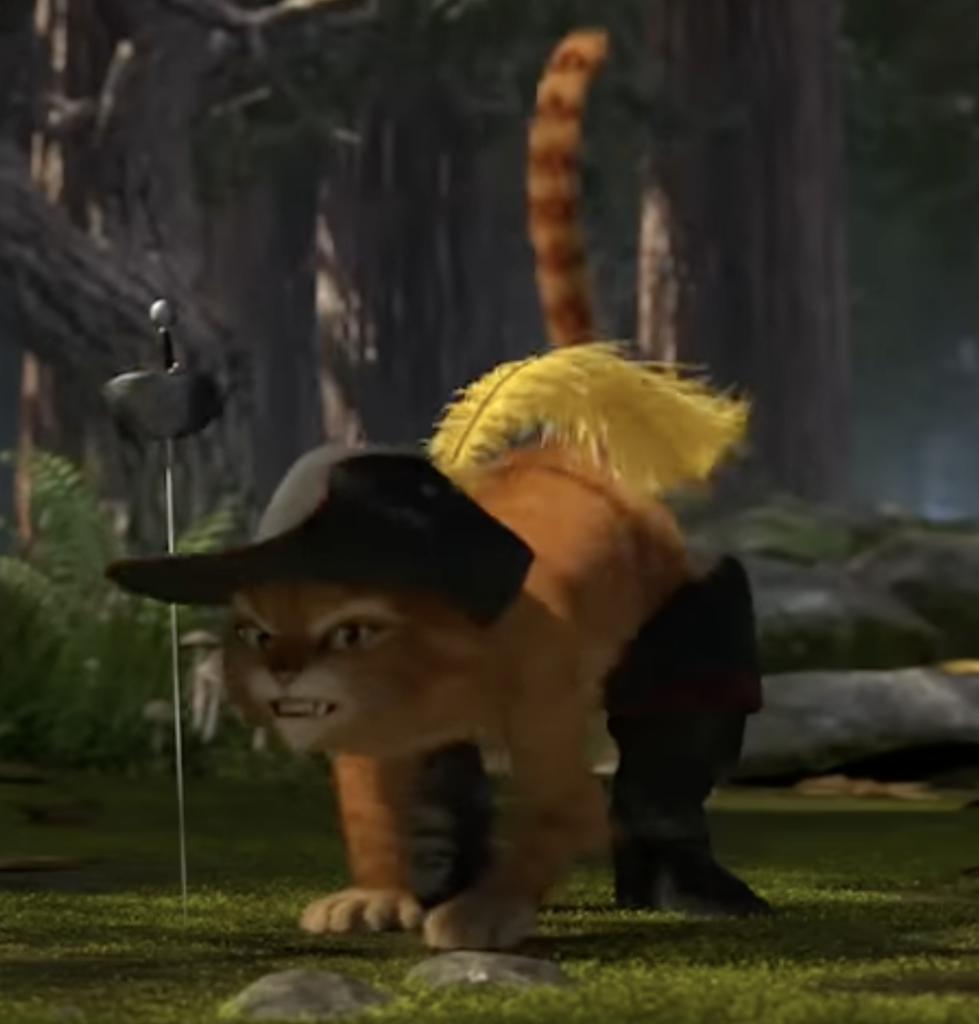
Despite his human attire, rapier and bipedalism, Puss instead chooses to attack Shrek like a stereotypical cat, by latching onto him and scratching. Immediately, we see the deterioration of Puss’ supposed chivalry and sense of justice we would expect from a musketeer. The audience is made to believe that Puss is a cruel assassin by the inhabitants of Far Far Away, yet the hint of naturalism as to how a feline would actually act in a fight allows for a comedic battle between the cat and ogre. When engaged in battle, Puss becomes incredibly feral, losing his usually civilised behaviour. After Donkey ‘saves’ Shrek, Puss threatens them once again, only to fall to the floor spluttering. The dramatic music cuts out, and we are made to watch a cringe inducing, drawn out scene (see figure 3) of Puss coughing up a hairball – a literal ‘gag’. This comedic vignette is common in animation, as it allows for a break in the plot in order to establish some visual comedy. Once Puss finally stop coughing, he looks sheepish and exclaims, “Heh heh. Furball!” Despite him already exhibiting normal feline behaviour whilst fighting Shrek, Puss is still embarrassed by it, showing his social consciousness of acceptable behaviour. This irony allows for the scene to become even more comedic when factoring in his hybridity of being a ‘musketeer cat’. A cat throwing up a hairball is quite humorous anyway (if a bit juvenile), but adding in Puss’ sheepish reaction allows for another layer of comedy. Puss wants to upkeep the appearance of a noble assassin, but his reality of being a cat betrays how he wants to present himself.
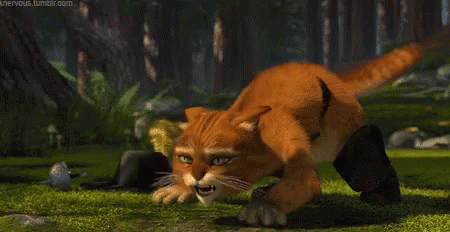
When Shrek and Donkey go to leave the forest, Puss insists he comes with them, on ‘his honour.’ Donkey refuses, claiming “The position of annoying talking animal has already been taken!” The irony already established in this scene is taken to a meta-textual level, as a character from the film is able to comment on the usual constraints of the fairy tale genre. Under the usual rules of the genre, Shrek and Donkey would forgive Puss, and willingly accept him into their party to defeat the ‘bad guys’. However, since Shrek is a parody of all these tropes, Donkey breaks the fourth wall and comments that Puss, the assassin turned laughingstock, cannot take his comedic role in the story.
As he was not instantly accepted to join Shrek and Donkey in their adventures, Puss-in-Boots turns on the charm, in perhaps one of the most famous scenes in the Shrek franchise. Instead of being betrayed by his feline appearance and nature, he uses it to his advantage, widening his eyes and clutching his hat cutely (figure 4). Puss, up to this point, has already embarrassed himself due to being a cat, but in this moment, he can use this fact to his advantage. This is where we see something of an allusion to the original story of Puss-in-Boots, in which he is a deceitful trickster. His cuteness allows Shrek to let down his guard again, and despite Donkey’s protests, he is allowed into their party. Overall, Shrek 2 uses the hybridity of Puss’ feared musketeer persona and his naturalistic cat behaviour to create a comedic character out of the classic children’s story.
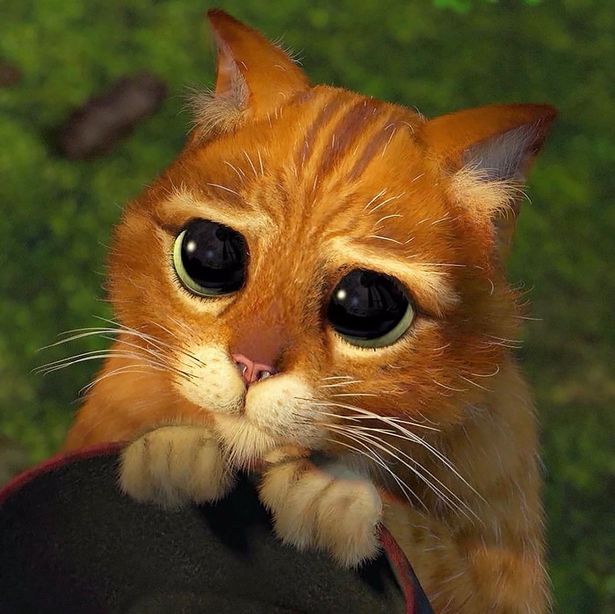
Bibliography
Brown, J. “How to Satisfy Cat Hunting Instincts Appropriately”, Catster, 31 Oct 2017, https://www.catster.com/cat-behavior/how-to-satisfy-cat-hunting-instincts, Accessed 31 Dec 2022
Shrek 2 (2004) Directed by Adamson, A., Asbury, K, Vernon, C., DreamWorks Pictures, Accessed via Netflix
